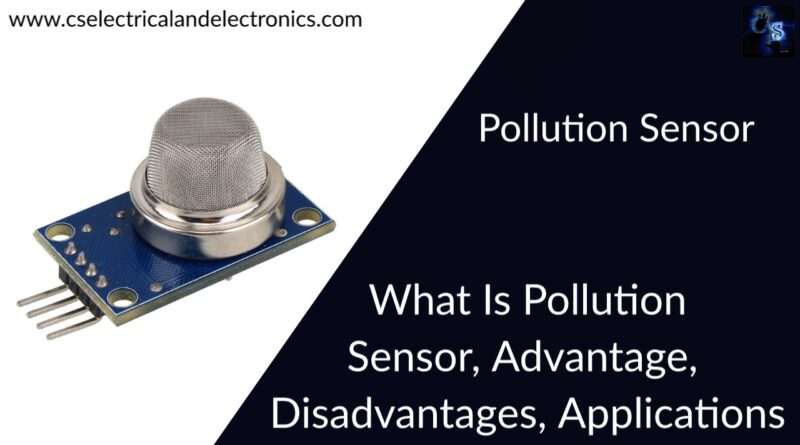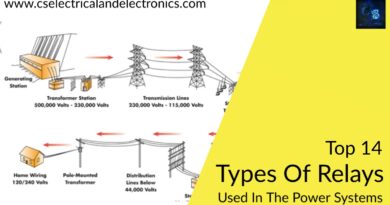What is Pollution Sensor, Advantages, Applications Of Pollution Sensor
Hello guys, welcome back to my blog. In this article, I will discuss what is pollution sensor, its working, advantages, disadvantages, applications of pollution sensor, etc.
If you have any doubts related to electrical, electronics, and computer science, then ask question. You can also catch me @ Instagram – Chetan Shidling.
Also, read:
- What Is Interrupt, Interrupts Handling, Interrupt Service Routine
- What Is FPGA, Field Programmable Gate Array, FPGA Tools
- What Is IEEE, How To Publish Research Paper At IEEE, IEEE Membership
What is Pollution Sensor
Air pollution sensors are devices that measure the amount of pollution in the air around them. They are suitable for both indoor and outdoor use. These sensors can be made by yourself or purchased from a variety of manufacturers.
Although there are many different types of air pollution sensors, and some are focused on specific characteristics, the bulk of them focuses on five elements: ozone, particulate matter, carbon monoxide, sulfur dioxide, and nitrous oxide.
In the past, sensors were prohibitively expensive, but because of technological developments, they are becoming more inexpensive and widely available. These sensors may be used for a variety of things, including bringing attention to environmental concerns that aren’t visible to the naked eye.
The EPA maintains an air quality data archive called the Air Quality System (AQS), which has data from over 10,000 monitors around the country. While using these sensors was formerly prohibitively expensive, a new trend in the 2010s saw the introduction of less priced portable air-quality sensors that may be worn by anyone to monitor local air quality levels.
These sensors may then be used to assess the spatiotemporal coverage and diversity of chemical species, allowing people and communities to better understand their exposure environments and air pollution concerns.
Monitoring air quality is a well-known and well-established science that dates back to the 1980s. At the time, technology was limited, and the method for quantifying air pollution was sophisticated, laborious, and extremely costly.
Fortunately, today’s options for Air Quality monitoring are becoming not only more exact but also faster to measure, thanks to the most latest and sophisticated technology. Devices are shrinking in size and costing far less than in the past. New technologies, such as the Tapered element oscillating microbalance (TOEM), provide considerable benefits over classic Beta Attenuation Monitors (BAM).
Recently, ultra-affordable sensors have begun to appear on the market, many of which are connected to the IoT trend of detecting everything. While most of them are just gimmicks and hence worthless toys, some of them are beginning to attain performance equivalent to professional monitors for a hundred times less money.
The Earth Sensing Labs of the World Air Quality Index project has been performing various Air Quality Sensor research and live-data tests for many years to assess the dependability of such sensors.
Applications of the Pollution Sensor
01. Monitoring System for Indoor Air Quality
It’s surprising to learn that indoor air pollution kills almost 3.8 million people each year. When particulate matter and hazardous gases are present in the air, the quality of the air is lowered, which may lead to serious illnesses such as asthma, lowered lung function, and even cancer when breathed.
02. Monitoring System for Outdoor Air Quality
For decades, environmental health has been a hot subject. To maintain good air quality, many laws and regulations relating to pollutant emissions in the air have been established. As a result, companies must monitor the production of hazardous gases to maintain the emission rate well within the established standards.
03. Monitoring of Particulate Matter
Particulate matter (PM) or Particulates are tiny particles floating in the air that are solid or liquid. These particles, also known as aerosols, are invisible to the naked eye and can be made up of a variety of materials such as acids, metals, dirt, dust, organic compounds, and so on.
Because these particles are so tiny, they can easily be ingested and cause health problems. The size of these particles has a direct relationship with the severity of the health problems. Coarse PM, which may be found near roads or dusty industries, has a diameter of 2.5 to 10 micrometers.
Particles smaller than 2.5 micrometers, on the other hand, are more hazardous since they may readily travel through the nose and throat and into the lungs. As a result, businesses may take efforts to minimize aerosol concentrations in their facilities and provide a healthy work environment for their workers.
04. System for Detecting Gases
Even a tiny leak may cause a disaster in sectors like chemicals and oil & gas, where hazardous gases and poisons are either utilized or generated in or during industrial operations. Long periods of time spent working in the presence of H2S or SO2 can harm a worker’s respiratory system.
Long-term exposure can induce severe headaches, convulsions, nausea, and conjunctivitis, as well as impair mental health. Leaks of flammable gases like LPG or methane can also cause explosions, resulting in injuries to adjacent personnel and equipment damage. Furthermore, oxygen-displacing gases (also known as asphyxiants) such as methane or propane can lower oxygen levels, resulting in serious mental health problems and even death.
Advantages of the Pollution Sensor
01. Complement existing monitoring systems.
02. Management of emergency response, identification of harmful leaks, and monitoring of rule compliance at the source.
03. Improved prediction models and knowledge of the relationship between air pollution and human health.
04. Raising awareness in the community.
To sum up, The quality of air is determined by constituents such as particulate matter and gases. When breathed repeatedly, these contaminants degrade the quality of the air, causing serious illnesses.
Industries can identify the presence of these toxics and monitor air quality with air quality monitoring systems, allowing them to take sensible actions to enhance the air quality for their workers. As a result, production rises, equipment damage decreases, and regulatory compliance improve.
This was about ” What is Pollution Sensor “. I hope this article may help you all a lot. Thank you for reading ” What is Pollution Sensor “.
Also, read
- 100 + Electrical Engineering Projects For Students, Engineers
- 1000+ Electronics Projects For Engineers, Diploma, MTech Students
- 1000+ MATLAB Simulink Projects For MTech, Engineering Students
- 500+ Embedded System Projects For Engineer, Diploma, MTech, PhD
- 500+ Projects For Diploma Electrical, Electronics Student, Diploma Project
- 8051 Microcontroller Timers, TCON Register, TMOD Register
- Advancements In 3D Printing Technology And It’s Future
- Advancements In Power Electronics For Energy Efficiency
Author Profile
- Chetu
- Interest's ~ Engineering | Entrepreneurship | Politics | History | Travelling | Content Writing | Technology | Cooking
Latest entries
 All PostsApril 29, 2024Top 11 Free Courses On Battery For Engineers With Documents
All PostsApril 29, 2024Top 11 Free Courses On Battery For Engineers With Documents All PostsApril 19, 2024What Is Vector CANoe Tool, Why It Is Used In The Automotive Industry
All PostsApril 19, 2024What Is Vector CANoe Tool, Why It Is Used In The Automotive Industry All PostsApril 13, 2024What Is TCM, Transmission Control Module, Working, Purpose,
All PostsApril 13, 2024What Is TCM, Transmission Control Module, Working, Purpose, All PostsApril 12, 2024Top 100 HiL hardware in loop Interview Questions With Answers For Engineers
All PostsApril 12, 2024Top 100 HiL hardware in loop Interview Questions With Answers For Engineers








